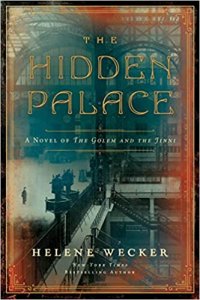Paul Di Filippo Reviews The Hidden Palace by Helene Wecker
 The Hidden Palace, Helene Wecker (Harper 978-0062468710, 480pp, $28.99) June 2021.
The Hidden Palace, Helene Wecker (Harper 978-0062468710, 480pp, $28.99) June 2021.
Helene Wecker’s sequel to her stunning 2013 debut, The Golem and the Jinni [reviewed here], succeeds 100 percent in recapturing the assured voice, the delicate magic, the solid historical verisimilitude, and the engaging interplay of personalities that she delivered in the first book. But she does not merely replicate all the pleasures, plot points, devices, and charms of the predecessor, but deepens, extends, and culminates all the arcs, leaving the reader very satisfied—yet with an expansive outlook for further adventures of our uncanny duo. The eight-year interval between the two books bespeaks immense diligence and artistry, but I must lodge a hope that any third volume comes sooner!
Very, very reductionistically, let us encapsulate the doings and cast of the first volume. An artificial woman, a traditional Jewish golem named Chava, is created in Europe, voyages to New York City circa 1900, and becomes a free agent, learning to fit in among humans. Meanwhile, in the same time and place, an ancient jinni, Ahmad, is freed by a human from his bottle imprisonment. Chava and Ahmad find each other in the lonely, swarming metropolis and become bosom buddies, more or less by default of having no other companions who could understand their peculiar existences. We experience the mundane and supernatural lows and highs of their lives in this lushly rendered era. But then the evil wizard who created Chava, Yehudah Schaalman, threatens their restless contentment until he is defeated in a slam bang climax.
The new book opens hard on the heels of the first. Chava continues her existence as head baker for the Radzins, while Ahmad has just returned to his metal-smithing shop and human partner Arbeely after a trip to his Middle Eastern homeland to bury the bottle containing the essence of Yehudah Schaalman. That journey will soon have vast repercussions, since he revealed himself to the native jinnis.
But before we watch the friendship between this unlikely pair blossom into something approaching star-crossed love, we pick up three other strands, all of which will tie in elegantly with the main arcs of Chava and Ahmad, during a real Gotterdammerung conclusion that tapers off into a bittersweet coda.
One strand concerns rich girl Sophia Winston. We saw her and Ahmad become fleeting lovers earlier. But the jinni’s intercourse has left Sophia with a damaged physiology, and she sets out for his homeland to seek a cure. This quest will eventually result in the arrival of a female jinni, a jinniyeh named Dima, in New York.
The second strand concerns a young girl named Kreindel Altschul. Her only living parent is the Rabbi Altschul, who happens to get a hold of some mystical texts that teach him how to create—a golem! With the help of Kreindel, the Rabbi does bring such a being to life. But then in a tragedy Kreindel is completely orphaned and she and the golem Yossele are cast upon a hard world.
Lastly we meet Toby, a messenger boy who is the child of one of Chava’s coworkers at the bakery. Fascinated by the oddball Chava, Toby and his brand of Baker Street Irregulars curiosity and ingenuity will eventually play a very consequential part in the tale.
Now, it’s plain to see what Wecker has done here, and it’s a smart move. In a nutshell, she has set up two new pairs of characters whose fates will mirror, echo, and counterpoint those of Chava and Ahmad in multiplex ways. Yossele serves as foil to Chava, two golems of supposedly identical existential nature, but actually oh-so-different. Dima serves the same function for Ahmad, her qualities counterpointing his. And the alternate pairing of Yossele with Dima forms another resonant grouping, damaged golem plus damaged spirit. Meanwhile, Toby and Kreindel, two humans, move in the same dance as the original golem and jinni. Toby, like Ahmad, is relatively blithe and carefree, while Kreindel, like Chava, is burdened, over-sensitive and gloomy. And when the paths of Kreindel and Chava intersect, after Chava has left the bakery for new employment, the two women display the sparks of like meeting like.
Halfway through the book, Chava and Ahmad have a very serious and seemingly permanent falling-out, which adds suspense to the second half of the tale. Will they ever get back together? Wecker tantalizes us right up to the end.
Nor does she neglect the maturation of her two main characters. What she focuses on is their development as artists. It turns out that dedication to, and passion for, their separate artforms is what was missing from—or only partly fulfilled by—the earlier lives of golem and jinni. Chava pursues her passion for teaching and cooking—the later nurturing artform ironic, in that her own nature needs no such sustenance. Meanwhile, Ahmad plunges into a hyperbolic dream of ironwork, creating the hidden palace of the title. This book then comes to function as a tale of two artists in a relationship where neither is willing to sacrifice for the other—until they learn better.
Wecker’s portrait of New York City from 1900 to 1915 has the bright substance and sheen of, say, an E.L. Doctorow or Jack Finney book. She does not rely overmuch on famous events or famous personalities (we do see the sinking of the Lusitania and the Triangle Shirtwaist Factory Fire), but rather delights in charting the lives of her average invented citizens and the societal and technological changes at large.
At one point Chava, woman of living clay, has been hurt. Ahmad is stroking Chava as reassurance.
One hand brushed along her hip; his fingers found a divot where the metal spar had pierced her. He winced, and moved his hand away. “Does that hurt?”
“No, it’s only a little numb. Like there’s a piece missing.”
“You’re well, then? Nothing permanent…?”
“Fully healed….”
“That’s good. I’m glad.”
And so this little seemingly minor passage symbolizes almost the whole novel: beings with tangible and intangible wounds seeking and giving comfort, and carrying on the spark of life as best they can.
 While you are here, please take a moment to support Locus with a one-time or recurring donation. We rely on reader donations to keep the magazine and site going, and would like to keep the site paywall free, but WE NEED YOUR FINANCIAL SUPPORT to continue quality coverage of the science fiction and fantasy field.
While you are here, please take a moment to support Locus with a one-time or recurring donation. We rely on reader donations to keep the magazine and site going, and would like to keep the site paywall free, but WE NEED YOUR FINANCIAL SUPPORT to continue quality coverage of the science fiction and fantasy field.
©Locus Magazine. Copyrighted material may not be republished without permission of LSFF.






